The price movements of financial assets occur through several phases like — accumulation, distribution, downtrend, uptrend, etc. Several strategies allow participants to make trades during various stages of the price movements.
Range strategies are trading methods that involve potentially profitable trading ideas to trade while price movement remains in a particular area.
It requires specific skills to identify ranges for making profitable trading positions. This article contains all the necessary information about range trading, such as the potentiality, profitability, and capital size is standard for range trading. Moreover, we describe short-term and long-term trading techniques using the range trading method.
Is a range trading strategy profitable?
Making constant profits from the FX market depends on several factors: trading style, strategies, trade management, money management, risk-reward ratio, etc. During the price movement, two different ranges can occur, such as ranges with closer support-resistance levels and ranges with standard price movements.
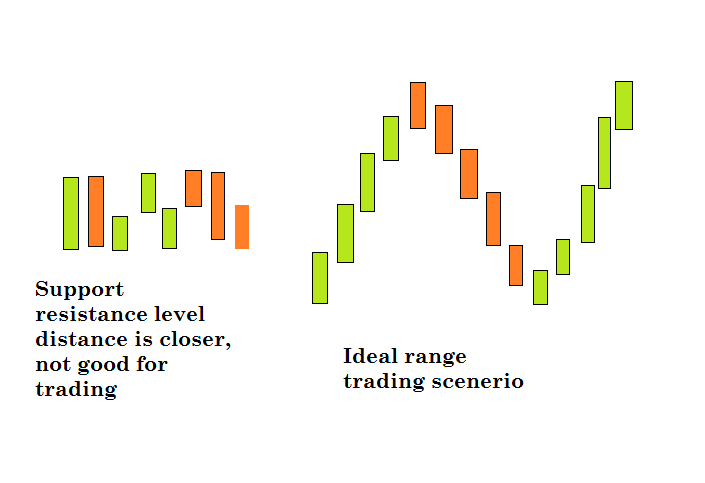
Ranges with short distance support-resistance levels are not suitable for range trading strategies. Traders often wait for a breakout in this situation. Many traders enter at the breakouts to make profitable trading positions.
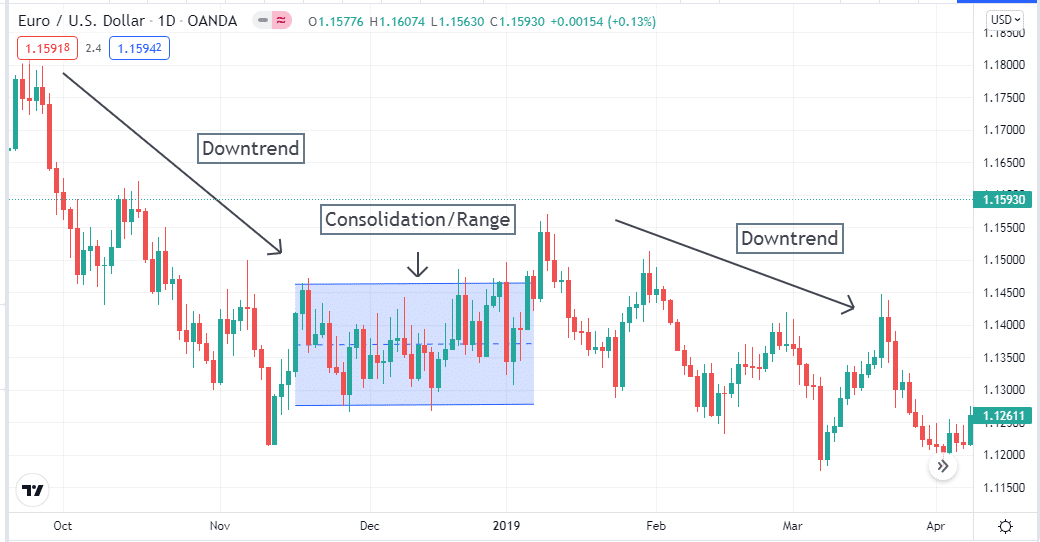
On the other hand, sufficient distance at the S/R levels in a particular range creates profitable trading opportunities. For example, any trading asset may be changing price between $30-$40 over a specific period, enabling traders to make considerable profits.
That profitability can increase if you use that range trading method in the FX market, as you can make money from both uptrend and downtrend price movements.
How much do forex traders make on a range trading strategy?
It is a very dependable question. The answer depends on several factors, such as trading skills, market environment, trading capital, risk-reward, etc. Your trading expectancy calculation will give you the idea mathematically as:
E= [1+ (W/L)] x P – 1
Where:
W= size of your average wins
L= size of your average loss
P=winning rate
Here’s an example:
You have made ten trades: six winnings and four losings. That means your percentage win ratio is 6/10 or 60%. If your six trades bring you a profit of $3,000, the average win is $3,000/6 = $500. If your losses are only $1,600, then your average loss is $1,600/4 = $400.
Next, apply these figures to the formula:
E= [1+ (500/400)] x 0.6 – 1 = 0.35 or 35%
This example shows the expectancy of your trading strategy is 35%, a positive expectancy. It means your trading strategy will return 35 cents for every dollar you trade over the long term.
Mainly how much you will make will depend on how much you are risking and trading skills. For instance, you can make $20,000 per year by risking $1000, $60,000 per year by risking $3000, or $100,000 per year by risking $5000.
A short-term strategy
When you want to apply any range trading strategy, you have to identify the S/R levels of the asset price. We use the hourly chart and stochastic oscillator beside support resistance for our short-term ranging method. When the blue line of the Stochastic indicator crosses above the red line, it signals bullish pressure and vice versa.
Bullish trade setup
Identify the top and bottom of the range. Observe the price movement at the support level. If the support level works fine and the price starts to retreat from the support level toward the resistance level, check the stochastic indicator window for more confirmation.
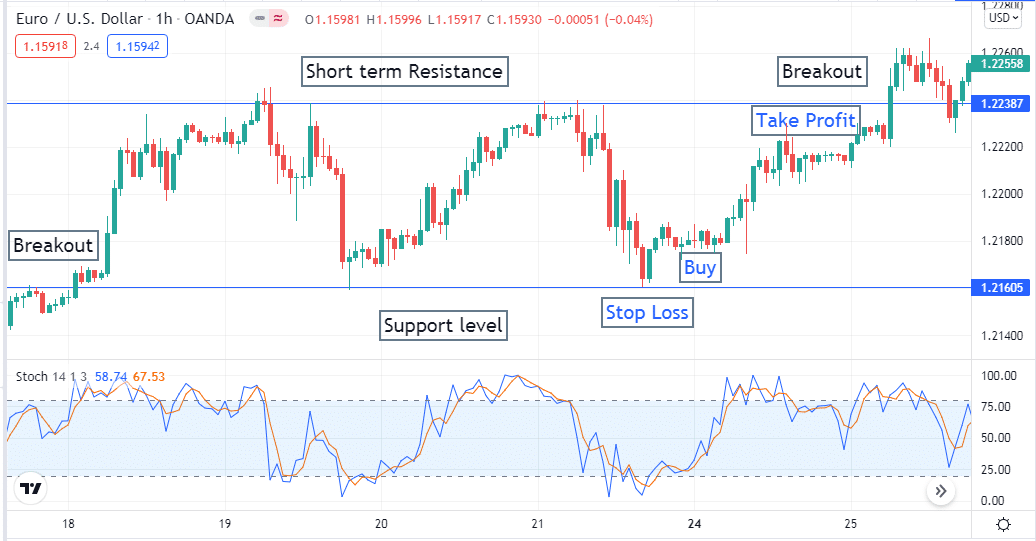
Place buy order when the bullish crossover occurs between stochastic signal lines and both lines move toward the resistance level. Stop loss will be below the support level, and take profit will be below the resistance level.
Bearish trade setup
Observe the price movement at the resistance level. When price starts to decline from the resistance level, check the Stochastic indicator window for more confirmation. Place sell order when the bearish crossover occurs between stochastic signal lines.
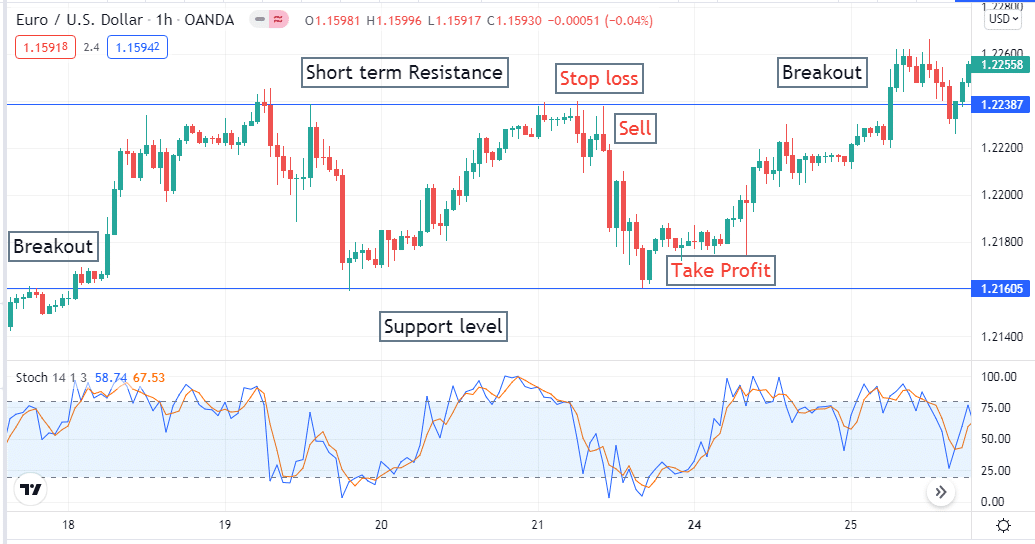
Put an initial stop loss above the resistance area with some buffer, and the take profit will be a few pips above the support area.
A long-term trading strategy
We use the MACD indicator beside support resistance levels in our long-term range trading strategy. When the blue signal line crosses above the red signal line of the MACD window, it indicates bullish pressure at the asset price and vice versa.
When asset price is bullish, MACD histogram green bars will appear above the middle line. For bearish price movement, red histogram bars will appear below the centerline of the MACD indicator window. This strategy works fine at any time frame chart; we use daily charts to generate long-term trade setups.
Bullish trade setup
When the price reaches the support level of the range, check the MACD indicator window. Place buy order when the bullish crossover occurs between MACD signal lines and green histogram bars appear above the middle line.
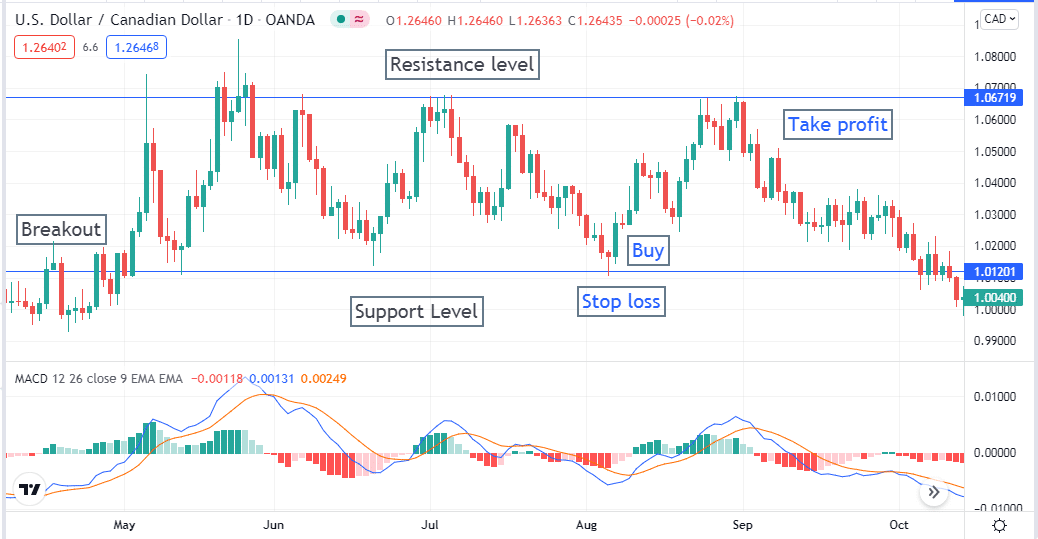
Place an initial stop loss below the support area with some buffer to avoid intraday volatility and take profit will be a few pips below the resistance level.
Bearish trade setup
When the price reaches the resistance level and starts to decline, check the MACD indicator window for confirmation. Red histogram bars appear below the middle line when the bearish crossover occurs between the MACD signal lines; it’s the right place to make sell positions.
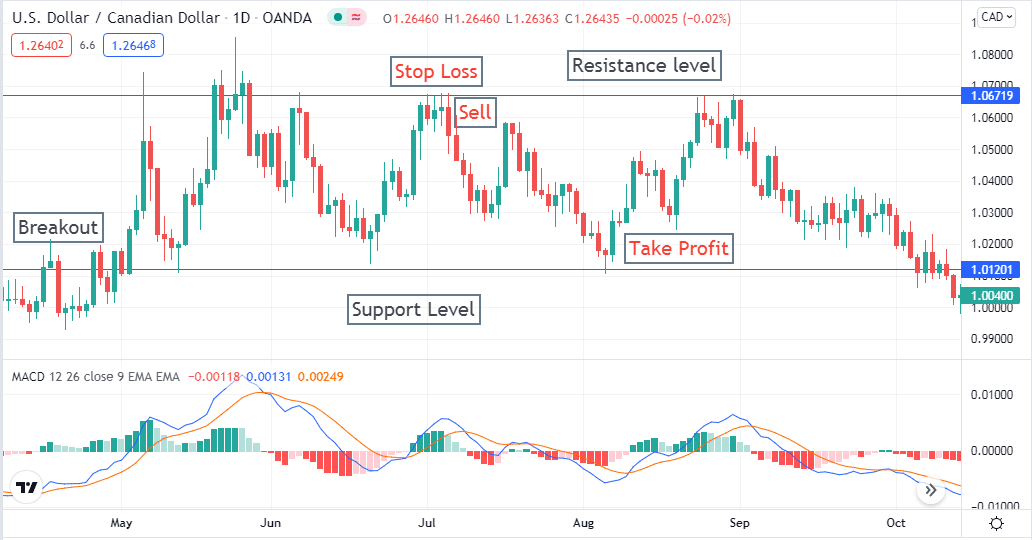
Put initial stop loss above the resistance level and take profit above the support level.
Pros & cons
Range trading also involves some limitations besides all advantages.
| Pros | Cons |
| You can trade with small funds. | No guarantee that the range will remain intact; breakout can occur anytime. |
| Placing a take profit and stop loss levels are comparatively easy. | Frequent trades involve more cost, commissions, etc. |
| You can make profits while the price is not trending. | It can be time-consuming to identify a suitable range. |
Final thought
Range trading strategies are unique techniques to make profits from ranging price movements. It’s prevalent in the forex market that currency pairs remain at a range before any significant fundamental economic event occurs. We suggest being careful to trade with these range trading strategies during any trend-changing economic events.




